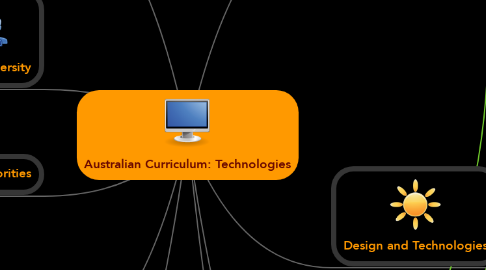
1. Cross Curriculum priorities
1.1. Aboriginal and Torres Strait Islander history and culture
1.2. Asia and Australia's engagement with Asia
1.3. Sustainability
2. Student diversity
2.1. ACARA is committed to providing a high quality curriculum that promotes excellence and equity for all Australian students including;
2.2. Students with a disability
2.3. Students who are learning English as a second language
2.4. Gifted or talented students
3. Curriculum aims and objectives
3.1. Develop knowledge, understanding and skills
3.2. Provide opportunities for independent and collaborative learning
3.3. Engage confidently with traditional, contemporary and emerging technologies
3.4. Critically select and use appropriate technologies for designing and creating products
3.5. Engage confidently with technologies to make informed judgements about technology that are ethical and sustainable
4. Digital Technologies
4.1. Knowledge and understanding
4.1.1. Symbolic representation of data
4.1.2. Components of digital systems
4.1.3. Influence of information systems in society
4.2. Process and production skills
4.2.1. Collecting, managing and interpreting data
4.2.2. Use a range of digital systems
4.2.3. Identify problems, implement solutions
4.2.4. Engage safely online using technical and social protocols
4.3. Key concepts/ideas
4.3.1. There are a number of key concepts that underpin the Digital Technology curriculum.
4.3.1.1. Abstraction
4.3.1.1.1. The skill of identifying and interpreting important and relevant information
4.3.1.2. Data collection, representation and interpretation
4.3.1.2.1. The ability to gather facts and information and represent this information symbolically and the ability to make meaning of this information.
4.3.1.3. Specification, algorithms and implementation
4.3.1.4. Digital systems
4.4. Band levels
4.4.1. Foundation to Year 2
4.4.2. Year 3 and Year 4
4.4.3. Year 5 and Year 6
4.4.4. Year 7 and Year 8
5. Design and Technologies
5.1. Knowledge and understanding
5.1.1. Technology in society
5.1.2. Technologies context
5.2. Process and production skills
5.2.1. Critiquing, exploring and generating
5.2.2. Planning, producing and evaluating designed solutions
5.3. Key concepts/ideas
5.3.1. There are a number of key concepts that underpin the Design and Technologies curriculum
5.3.1.1. Creating preferred futures
5.3.1.1.1. Students creatively and actively design solutions to meet present needs without compromising the ability of future generations to meet their needs.
5.3.1.2. Project management
5.3.1.2.1. Technologies projects involve ethical, health and safety considerations.
5.4. Band levels
5.4.1. Foundation to Year 2
5.4.2. Year 3 to Year 6
5.4.3. Year 7 to Year 10
6. General Capabilities will assist students to live and work successfully in the twenty first century
6.1. Numeracy NUM
6.2. Literacy LIT
6.3. Information and communication ICT technology
6.4. Critical and creative thinking CCT
6.5. Personal and social capability PSC
6.6. Ethical understanding
6.7. Intercultural understanding ICU
7. Content descriptions
7.1. The Australian Curriculum: Technologies includes content descriptions at each band level. These describe the knowledge, understanding and skills that teachers are expected to teach and students are expected to learn.
7.1.1. Content Elaborations
7.1.1.1. Content elaborations are provided for Foundation to Year 10 as support material to illustrate and exemplify what is to be taught and to assist teachers in developing a shared understanding of the content descriptions.
